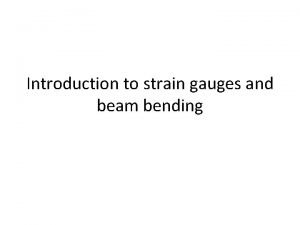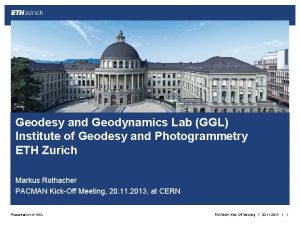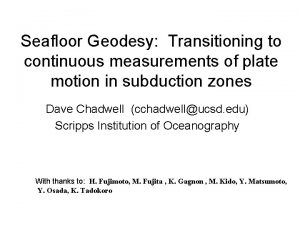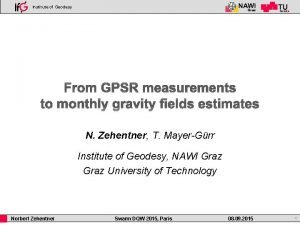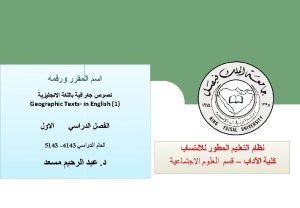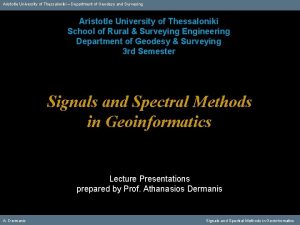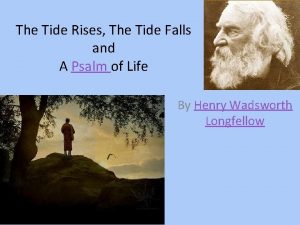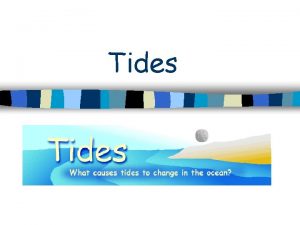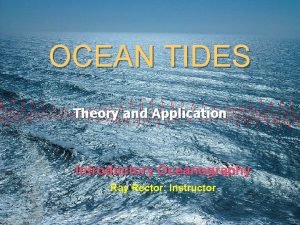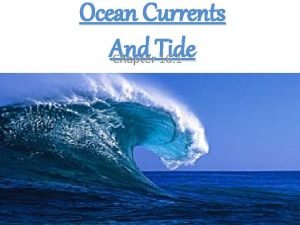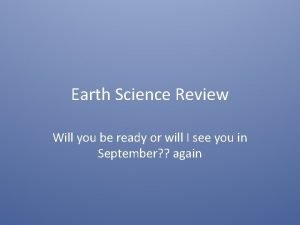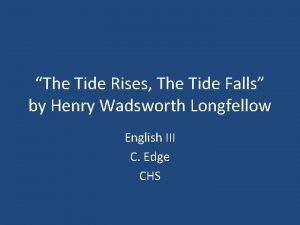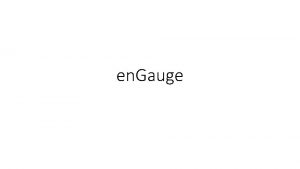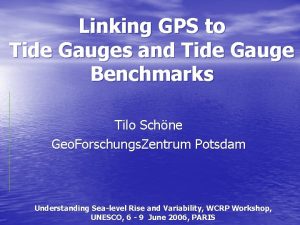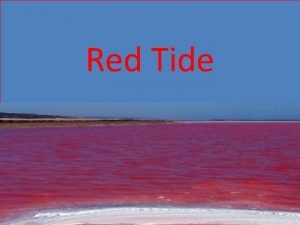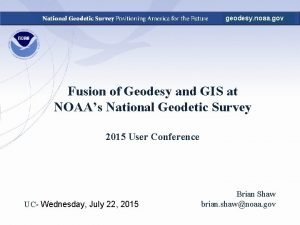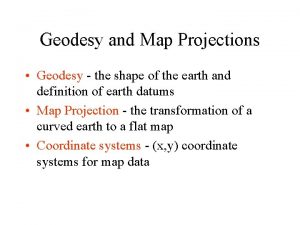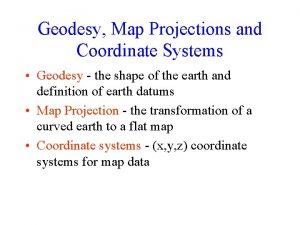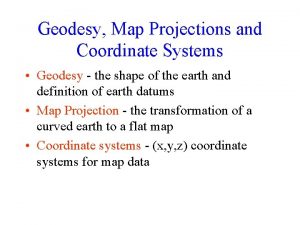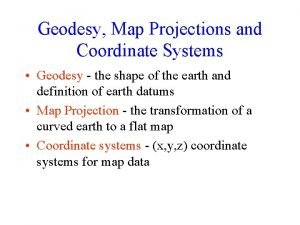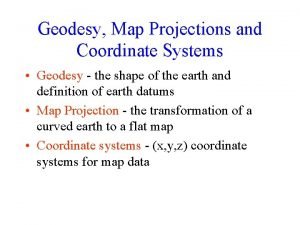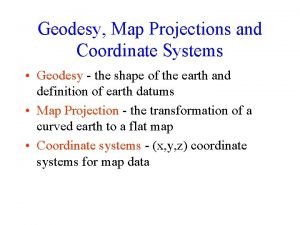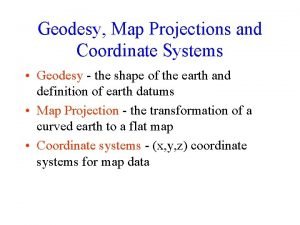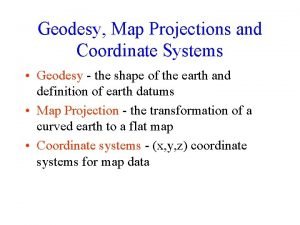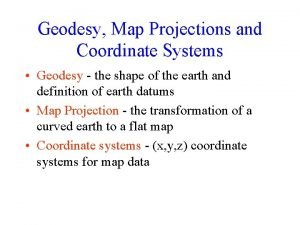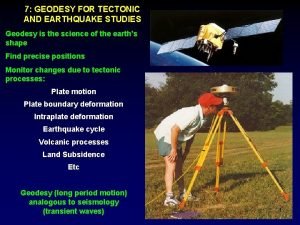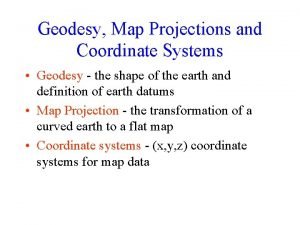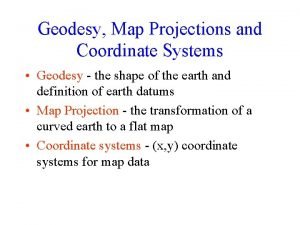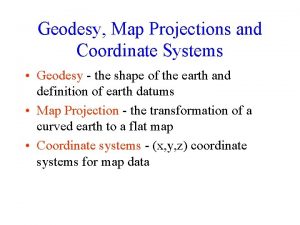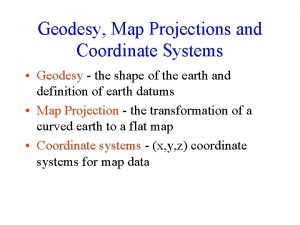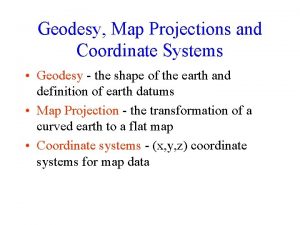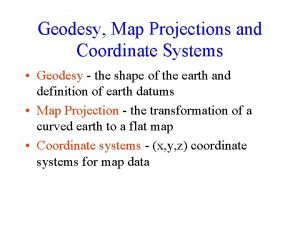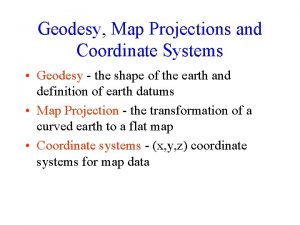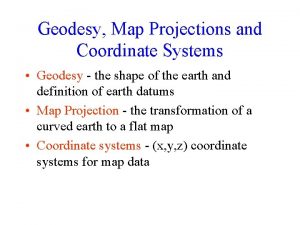Geodesy at a Tide Gauge Where the Tide












































- Slides: 44

Geodesy at a Tide Gauge Where the Tide Gauge Operator meets the Surveyor Tilo Schöne Geo. Forschungs. Zentrum Potsdam Phil Woodworth (PSMSL) & Simon Williams (POL) Correspondence: Tilo Schöne tschoene@gfz-potsdam. de

Introduction (0/6) “For sea level observations, a land benchmark is used as the primary reference point” (IOC Manuals and Guides No. 14, vol. IV) “TGBM’s should be connected to the International Terrestrial Reference Frame (ITRF) and monitored using GPS” (Carter et al. 1989) ODINAFRICA/GLOSS Sea Level Training Course - Oostende, Belgium - 13 -24 Nov. 2006

Introduction (1/6) • Why and How to measure and monitor the sea level was addressed already and you are the specialists • Why and how to geodetically fix the tide gauge benchmark(s) will be address in this lesson ODINAFRICA/GLOSS Sea Level Training Course - Oostende, Belgium - 13 -24 Nov. 2006

Introduction (2/6) • Why Geodesy at Tide Gauges? – Height reference for national height systems – Reference for local mapping – Long-term consistency for law-of-thesea (coastal/harbor navigation, claims of the continental shelf) – Scientific analyses (e. g. loading) – Predict risk of coastal flooding –… ODINAFRICA/GLOSS Sea Level Training Course - Oostende, Belgium - 13 -24 Nov. 2006

Introduction (3/6) • Tide Gauges give values in reference to their “technical” zero • Reference points (pole staff, benchmarks) are established to ensure consistency over time (e. g. replacement) • For scientific application a common (and global) reference frame is needed ODINAFRICA/GLOSS Sea Level Training Course - Oostende, Belgium - 13 -24 Nov. 2006

Introduction (4/6) • Relative and “absolute” sea level – e. g. Fenoscandian uplift (PGR: +1 cm/year), i. e. relative “sea level fall” is observed – e. g. German Coast subsides (PGR: -~1 mm/year), i. e. relative “sea level rise” Courtesy: G. Liebsch, TU Dresden ODINAFRICA/GLOSS Sea Level Training Course - Oostende, Belgium - 13 -24 Nov. 2006

Introduction (5/6) • Models (e. g. PGR) are insufficient to correct for local long-term vertical changes – Geological records are spanning thousand of years – Local effects may mask the regional values – Fast processes (e. g. earth quakes) and recent changes (e. g. reservoir changes) cannot be modeled ODINAFRICA/GLOSS Sea Level Training Course - Oostende, Belgium - 13 -24 Nov. 2006

Introduction (6/6) • Neither the Sea Level nor the Land Surface are constant or fixed over short or long-term Sea Level ? GPS co-seismic displacements Vigny: doi: 10. 1038/nature 03937 RLR series provided by PSMSL ODINAFRICA/GLOSS Sea Level Training Course - Oostende, Belgium - 13 -24 Nov. 2006

Summary (Introduction) • Fast and efficient methods are needed for height control and monitoring of the tide gauges – Should be long-term available – Easy to operate – Cost effective – Benefitary to other fields – Should be operated by a service ODINAFRICA/GLOSS Sea Level Training Course - Oostende, Belgium - 13 -24 Nov. 2006

Geodetic Methods Altimetry Gravity In. SAR Absolute Gravity GPS Tide Gauge Leveling h Courtesy: J. Müller Geoid ODINAFRICA/GLOSS Sea Level Training Course - Oostende, Belgium - 13 -24 Nov. 2006

Methods for Height Determination • Space Geodetic Techniques* – GPS, (GLONASS, GALILEO) – DORIS – (SLR, VLBI) • Absolute Gravity • Spirit Leveling *Stable Reference / Reference Frame is needed ODINAFRICA/GLOSS Sea Level Training Course - Oostende, Belgium - 13 -24 Nov. 2006

Space Geodetic Techniques Microwave Techniques: • Global Positioning System (GPS): USA • Global Navigation Satellite System (GLONASS): Russian Pendant • GALILEO: future European satellite navigation system • DORIS: French doppler satellite tracking system DORIS GPS GLONASS GALILEO ODINAFRICA/GLOSS Sea Level Training Course - Oostende, Belgium - 13 -24 Nov. 2006

Space Geodetic Techniques • VLBI (Very Long Baseline Interferometry): observation of quasars with large radio telescopes • SLR (Satellite Laser Ranging) and LLR (Lunar Laser Ranging): observation of special Earth satellites and the Moon with short laser pulses QUASAR VLBI LAGEOS SLR ODINAFRICA/GLOSS Sea Level Training Course - Oostende, Belgium - 13 -24 Nov. 2006

Stable Reference Frame (1/4) Terrestrial Reference Frames • Enables measurements to be related over time • One of the biggest source of errors in quantifying long-term variation in sea level • 2 mm/yr origin error (Center of mass) 0. 4 mm/yr in global sea level from satellite altimetry • 0. 1 ppb/yr (10 -10/yr) scale error 0. 6 mm/yr global sea level rate

Stable Reference Frame (2/4) • Every point on Earth is subject to vertical movements by e. g. – Post-glacial rebound – Subsidence, post-seismic effects – natural gas extraction, ground water usage, rebuilding harbors – Loading effects (atmosphere, tides) ODINAFRICA/GLOSS Sea Level Training Course - Oostende, Belgium - 13 -24 Nov. 2006

Stable Reference Frame (3/4) • Reference is established by a series of discrete points, itself subject to – Benchmark instabilities – Measurement insufficiencies – Equipment changes – Inaccurate local ties (!) ODINAFRICA/GLOSS Sea Level Training Course - Oostende, Belgium - 13 -24 Nov. 2006

Stable Reference Frame (4/4) • IERS combines, updates and publishes ITRF coordinates as their main product • Recently the ITRF 2005 became officially • ITRF is a combination of VLBI, SLR and GPS on a high level of confidence ODINAFRICA/GLOSS Sea Level Training Course - Oostende, Belgium - 13 -24 Nov. 2006

Methods for Height Determination • Space Geodetic Techniques* – GPS, (GLONASS, GALILEO) – DORIS – (SLR, VLBI) • Absolute Gravity • Spirit Leveling * *Stable Reference / Reference Frame is needed ODINAFRICA/GLOSS Sea Level Training Course - Oostende, Belgium - 13 -24 Nov. 2006

GPS (Introduction) • Technique has been established as a scientific tool since around 1993 • GPS is now the most common technique for point monitoring • Scientific organization (IGS/GGOS/IAG) is providing a high quality service (provision of orbits, clocks, point coordinates and velocities) (see http: //igscb. nasa. jpl. gov) • GPS is a multi-purpose sensor ODINAFRICA/GLOSS Sea Level Training Course - Oostende, Belgium - 13 -24 Nov. 2006

GPS with Choke Ring Antenna Satellite Communication Meteo-Sensor Solar Power Radar TG Floating TG and Pressure TG are complementing the setup ODINAFRICA/GLOSS Sea Level Training Course - Oostende, Belgium - 13 -24 Nov. 2006

GPS inside 2 -Frequency Geodetic Receiver Sampling 1 Hz to 30 sec ODINAFRICA/GLOSS Sea Level Training Course - Oostende, Belgium - 13 -24 Nov. 2006

IGS-GPS network and c. GPS@TGs IGS network: • • © IGSCB Geographically balanced Some clustering in populated areas Optimized point distances Strict requirements on latency (minutes to a few days) c. GPS@TG: • Sites along coastlines • Many clusters in Europe, Japan, USA • Short GPS baselines, sometimes multiple receivers at one site • Many remote and manually operated sites ODINAFRICA/GLOSS Sea Level Training Course - Oostende, Belgium - 13 -24 Nov. 2006

TIGA Tide Gauge Benchmark Monitoring Pilot Project of the IGS op. gfz-potsdam. de/tiga ODINAFRICA/GLOSS Sea Level Training Course - Oostende, Belgium - 13 -24 Nov. 2006

TIGA Pilot Project • Initiated in 2001 • Goals are – Establish, maintain and expand a global c. GPS@TG network – Compute precise station parameters for the c. GPS@TG stations with a high latency – Reprocess all previously collected GPS data at c. GPS@TG stations, if possible back to 1993 – Promote the establishment of links to other geodetic sites which may contribute to vertical motion determination (DORIS, SLR, VLBI, AG) ODINAFRICA/GLOSS Sea Level Training Course - Oostende, Belgium - 13 -24 Nov. 2006

TIGA Pilot Project • 102 out of 280 c. GPS@TG stations contribute • Processing latency 460 days • Six analysis centers provide solutions • Forward (since GPS week 1121) and backward processing on a best-effort basis • Backward processing to 1993 • Preparations for the combination started at GFZ; will provide a combination solution on a regular basis ODINAFRICA/GLOSS Sea Level Training Course - Oostende, Belgium - 13 -24 Nov. 2006

TIGA Network Geoscience Australia TOS fully accepted Proposed CTA EUREF DGFI GFZ ULR ODINAFRICA/GLOSS Sea Level Training Course - Oostende, Belgium - 13 -24 Nov. 2006

GPS: Recommendations • Each long-term and reliable tide gauge should be equipped with continuous GPS • If (for practical or budgetary reasons) impossible, establish a pillar for regularly repeated GPS campaigns • Single/Dual receiver concept – Primary GPS + additionally GPS marker within less than 10 to 50 m • Best, on top of the system (even if obstructions) • Continuously operating – Secondary GPS on stable ground • Continuously operating ODINAFRICA/GLOSS Sea Level Training Course - Oostende, Belgium - 13 -24 Nov. 2006

GPS: Recommendations • Dual frequency receivers and Choke Ring Antenna • 30 Sec sampling (1 Hz if hazardous area) • Short latency for data transmission • No obstructions around, use safe places, and no radio interference • Prevent multipath, e. g. from roofs, walls or the pillar itself • Leveling benchmark at the GPS pillar and regular leveling to other benchmarks ODINAFRICA/GLOSS Sea Level Training Course - Oostende, Belgium - 13 -24 Nov. 2006

GPS: Recommendations • Supply meta data (tide gauge data, meteorological data, equipment changes, unusual impacts, reconstruction works) • For guidelines how to build reliable GPS pillars refer to the IGS web page • GPS does NOT “solve everything for nothing”. Keep your first-order leveling capability, before you retire -> teach! ODINAFRICA/GLOSS Sea Level Training Course - Oostende, Belgium - 13 -24 Nov. 2006

Methods for Height Determination • Space Geodetic Techniques* – GPS, (GLONASS, GALILEO) – DORIS – (SLR, VLBI) • Absolute Gravity • Spirit Leveling * *Stable Reference / Reference Frame is needed ODINAFRICA/GLOSS Sea Level Training Course - Oostende, Belgium - 13 -24 Nov. 2006

Absolute Gravity: Introduction • The “Carter reports” on sea level monitoring recommended the use of Absolute Gravity (AG) as a complimentary technique to CGPS for VLM monitoring. • Results from AG measurements at UK tide gauges are presented ODINAFRICA/GLOSS Sea Level Training Course - Oostende, Belgium - 13 -24 Nov. 2006

Absolute Gravity How do we Measure “g”? . . G = Gravitational Constant = 6. 67 x 10 -11 m 3 kg-1 s-2 Me = Mass of the Earth Re = Radius of the Earth Using free fall methods. x = g integrating twice with respect to time gives the equation of motion 1 x = x 0 + v 0 t + gt 2 2 Measure x and t of a mass in free fall (in a vacuum) and use the above equation to get g. ODINAFRICA/GLOSS Sea Level Training Course - Oostende, Belgium - 13 -24 Nov. 2006

Absolute Gravity This machine has a precision and accuracy of about 1 -2 mgal (1 mgal =10 -8 ms-2) (1 mgal 5 mm vertical motion) ODINAFRICA/GLOSS Sea Level Training Course - Oostende, Belgium - 13 -24 Nov. 2006

Absolute Gravity So how does measuring g give us changes in vertical land movement? If additional mass is involved then Differentiate the basic equation with respect to distance Re dg - 2 GM e - 2 g = Dg = = 3 d Re Re Re = - 3. 1 e - 6 ms - 2 per m This assumes there is no additional mass : “Free Air Model” This is the “Bouger Model” ODINAFRICA/GLOSS Sea Level Training Course - Oostende, Belgium - 13 -24 Nov. 2006

ODINAFRICA/GLOSS Sea Level Training Course - Oostende, Belgium - 13 -24 Nov. 2006

Methodology • Measure for at least 3 days at each site, at least once per year (hopefully!) • Data from each day are processed separately and correction made for solid-earth tides, ocean-loading effects, atmospheric pressure, polar motion and comparator response. • Single admittance factor and local pressure data are used to correct for atmospheric pressure. • Gravity gradients for Newlyn and Aberdeen determined using a relative spring gravimeter ODINAFRICA/GLOSS Sea Level Training Course - Oostende, Belgium - 13 -24 Nov. 2006

Results ODINAFRICA/GLOSS Sea Level Training Course - Oostende, Belgium - 13 -24 Nov. 2006

GPS versus Absolute Gravity and Vertical Land Movement ODINAFRICA/GLOSS Sea Level Training Course - Oostende, Belgium - 13 -24 Nov. 2006

Absolute Gravity: Conclusions • AG measurement spanning 5 -6 years can be used to measure vertical land movements at tide gauges. • Absolute Gravity is a useful complimentary technique to CGPS. • Good site selection is essential to AG measurement success. • Given a few more years of measurement, results can be used to test competing GIA models. ODINAFRICA/GLOSS Sea Level Training Course - Oostende, Belgium - 13 -24 Nov. 2006

Methods for Height determination • Space Geodetic Techniques* – GPS, (GLONASS, GALILEO) – DORIS – (SLR, VLBI) • Absolute Gravity • Spirit Leveling * • Stable Reference / Reference Frame is needed ODINAFRICA/GLOSS Sea Level Training Course - Oostende, Belgium - 13 -24 Nov. 2006

Leveling (Introduction) • Leveling is needed for local surveys (stability, re-installation, equipment changes) • Time consuming and expensive • Only for short distances • Sub-mm accuracy achievable • Local set of benchmarks is already available (TG operator duties) ODINAFRICA/GLOSS Sea Level Training Course - Oostende, Belgium - 13 -24 Nov. 2006

Leveling (Technique) • Addressed later ODINAFRICA/GLOSS Sea Level Training Course - Oostende, Belgium - 13 -24 Nov. 2006

Leveling (Benchmarks) • • • Brass or aluminium casting Set in bedrock Easy to access Well documented (meta data) Should be made public to scientists Additional markers if unstable or destroyed ODINAFRICA/GLOSS Sea Level Training Course - Oostende, Belgium - 13 -24 Nov. 2006

Leveling (Recommendations) • Preferable 5+ leveling markers on stable ground within 5 to 500 m • Connection to the GPS benchmark • Re-leveling at least annually (more frequent if geological situation is instable), Documentation (!) • For extended surveys use first order leveling (0, 2 mm/km) • For points more that 1 km away achieving the required accuracy is unlikely !! ODINAFRICA/GLOSS Sea Level Training Course - Oostende, Belgium - 13 -24 Nov. 2006
 Solids mechanics
Solids mechanics Institute of geodesy and photogrammetry
Institute of geodesy and photogrammetry Geodesy and geomatics engineering
Geodesy and geomatics engineering Space geodesy facility
Space geodesy facility Seabed geodesy
Seabed geodesy Geodesy
Geodesy Branches of geodesy
Branches of geodesy Geodesy
Geodesy The tide rises, the tide falls
The tide rises, the tide falls The difference between spring tides and neap tides
The difference between spring tides and neap tides Essentials of oceanography
Essentials of oceanography Spring tide vs neap tide diagram
Spring tide vs neap tide diagram Neap tide spring tide
Neap tide spring tide The tide rises the tide falls paraphrase
The tide rises the tide falls paraphrase Môn thể thao bắt đầu bằng từ chạy
Môn thể thao bắt đầu bằng từ chạy Khi nào hổ mẹ dạy hổ con săn mồi
Khi nào hổ mẹ dạy hổ con săn mồi điện thế nghỉ
điện thế nghỉ Các loại đột biến cấu trúc nhiễm sắc thể
Các loại đột biến cấu trúc nhiễm sắc thể Thế nào là sự mỏi cơ
Thế nào là sự mỏi cơ Trời xanh đây là của chúng ta thể thơ
Trời xanh đây là của chúng ta thể thơ Gấu đi như thế nào
Gấu đi như thế nào Thiếu nhi thế giới liên hoan
Thiếu nhi thế giới liên hoan Vẽ hình chiếu vuông góc của vật thể sau
Vẽ hình chiếu vuông góc của vật thể sau Các châu lục và đại dương trên thế giới
Các châu lục và đại dương trên thế giới Một số thể thơ truyền thống
Một số thể thơ truyền thống Thế nào là hệ số cao nhất
Thế nào là hệ số cao nhất Frameset trong html5
Frameset trong html5 Hệ hô hấp
Hệ hô hấp Tư thế ngồi viết
Tư thế ngồi viết Số nguyên tố là gì
Số nguyên tố là gì đặc điểm cơ thể của người tối cổ
đặc điểm cơ thể của người tối cổ Mật thư tọa độ 5x5
Mật thư tọa độ 5x5 Thang điểm glasgow
Thang điểm glasgow ưu thế lai là gì
ưu thế lai là gì Thẻ vin
Thẻ vin Cái miệng nó xinh thế
Cái miệng nó xinh thế Các châu lục và đại dương trên thế giới
Các châu lục và đại dương trên thế giới Bổ thể
Bổ thể Từ ngữ thể hiện lòng nhân hậu
Từ ngữ thể hiện lòng nhân hậu Diễn thế sinh thái là
Diễn thế sinh thái là Tư thế ngồi viết
Tư thế ngồi viết V. c c
V. c c 101012 bằng
101012 bằng Thơ thất ngôn tứ tuyệt đường luật
Thơ thất ngôn tứ tuyệt đường luật Hát lên người ơi alleluia
Hát lên người ơi alleluia
